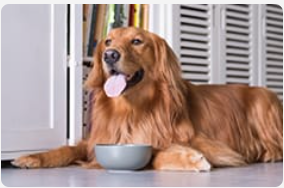

Diabetes in Dogs
Monitoring Urine Glucose & Ketones
Tracking Diabetes in Your Dog’s Urine
Monitoring Glucose and Ketones in Your Dog’s Urine
Immediately following diagnosis, your veterinarian may ask you to check your pet’s urine to monitor glucose and ketones. Depending on your pet, this may be done 1–3 times a day:
- Early in the morning, just prior to the time of the Vetsulin® injection and first meal
- Late in the afternoon, before the second meal
- Late in the evening
If monitoring once daily, the measurement should occur at the same time every day.
Collecting Urine
As treatment progresses, less frequent testing will be needed. Regular examinations remain important though, because your dog’s insulin needs can change.
Tools for Collecting
- Clean containers for collecting urine
- Urine dipsticks from your veterinarian
- A place to record results
How to Collect
- Take your dog out for a walk on a leash. Keep your dog on a leash so that he will be within reach when he urinates
- Have a clean, dry container (dish, bowl, or small pan) ready to catch urine when your dog urinates
- When your dog begins to urinate, slowly slide the container under the urine stream
- If needed, long-handled devices are also commercially available to help facilitate urine collection
Using Urine Dipsticks

Step 1
Read instructions for dipsticks you are using to ensure proper use

Step 2
Remove one test strip and fully immerse in urine to ensure all pads are soaked.

Step 3
Immediately remove the test strip and tap to remove excess urine.

Step 4
Read the result after the time specified on the dipstick bottle.

Step 5
Hold the stick against the chart on the dipstick container to compare colors.

Step 6
Record the results. Include time of collection and time of Vetsulin dose given on that day.
Tracking Results

Recording your dog’s results is important to properly manage care. Keep track using the Pet Diabetes Tracker app or download a copy of the management monitoring sheet.
Tracking Tools & Resources
- Pet Diabetes Tracker app
Review and keep important information to manage care. - Blood Glucose Curve Tool
Easily record blood glucose readings to generate a blood glucose curve. - Helpful Downloads
Additional resources to understand and manage canine diabetes.
Further Reading


Talk to Your Vet Today
Find a veterinarian to learn more about pet diabetes, and how cats and dogs can lead a happy, healthy life with proper management.
IMPORTANT SAFETY INFORMATION:
VETSULIN® and VETPEN® are for use in animals only. Dogs and cats known to have an allergy to pork or pork products should not be treated with VETSULIN®. VETSULIN® is contraindicated during periods of hypoglycemia. Animals with severe ketoacidosis, anorexia, lethargy, and/or vomiting should be stabilized with short-acting insulin and appropriate supportive therapy before use. As with all insulin products, careful patient monitoring for hypoglycemia and hyperglycemia is essential. Overdosage can result in profound hypoglycemia and death. Progestogen and glucocorticoid use should be avoided. The safety and effectiveness of VETSULIN® in puppies, kittens, breeding, pregnant, and lactating dogs and cats has not been evaluated. Keep out of reach of children. Avoid contact with eyes. In case of contact, immediately flush eyes with copious amounts of water for at least 15 minutes. Accidental injection may cause clinical hypoglycemia. In case of accidental injection, seek medical attention immediately. Exposure to the product may induce a local or systemic allergic reaction in sensitized individuals. For complete safety information, refer to the product label.




